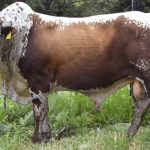ZIMBABWE HERD BOOK-YEAR OF THE NKONE 2023
NEWSLETTER FROM HHN and MH NKONE STUDS
No 5 (30th OCTOBER 2022)
By SEKURU
Ticks and Dipping
Tim Savory and I discussed tick challenges and dipping intervals the other day. I think Tim was a little surprised when I said that we regularly dipped every week throughout the year, particularly as we have what is considered a “tick and disease resistant breed”. Tim used to farm Nkone cattle at Rhodesdale in the Midlands in times gone by and was on the Society Committee.
Research has shown that the Nkone is resistant to tick infestation compared to exotic breeds. The smooth sleek, non-hairy coats and tick-repellent oily secretions in the skin of the Nkone discourage ticks and their attachment. The Nkone is able to “shiver” its skin on different parts of the body when it feels a tick or fly moving about, possibly helping to prevent attachment. I have seen this ability in wild animals, which also groom themselves and each other (allopreening). I have also seen allopreening to some extent in the Nkone, particularly amongst related animals and between bulls and cows. The long bushy-ended tails of the Nkone can reach many parts of the body, and as well as deterring flies, probably flick off unattached ticks.
So, we have a situation where the Nkone carries a lot fewer ticks than less resistant breeds, and this would also reduce the incidence of tick-borne disease in Nkone. Importantly, I do believe that our Nkone have some resistance to tick-borne disease BUT grazing our herd in a highly prevalent disease area, we are not prepared to take the chance to prove our Nkone are disease resistant and lose large numbers of valuable cattle. I agree there is some resistance to certain diseases in the Nkone and other indigenous breeds and this resistance can be built up, but with the wide-spread prevalence of serious tick-borne disease in all areas of the country at present, this could be at great cost in deaths and reduction in numbers.
I have no proof of this, but during the Rinderpest outbreak of 1896 when 80-90% of Zimbabwean cattle died and then later many more died from East Coast Fever in 1901-1903, infected by cattle introduced to rebuild the Zimbabwean herd. One wonders if our few surviving indigenous cattle then had some resistance to these diseases and therefore survived? Surely that specific resistance then could no longer apply? In the last few years, East Coast Fever has returned, and it is still a deadly killer.

Theileriosis, East Coast Fever, Gallsickness, Redwater and Heartwater are serious tick-borne diseases that occur countrywide and are now very common specifically in our area. Neighbours in the area have had outbreaks of disease and lost large numbers of valuable cattle. We have had three deaths since March 2019 due to suspected tick-borne disease and two calves with sweating sickness in the same period. In our herd sweating sickness seems to occasionally occur in late-born calves in very wet seasons. We are happy to keep tick-borne mortality down to, or below this level, whether it is the Nkone resistance to disease or our dipping programme, we will stay with the status quo.
We do not generally dip calves from birth until after weaning at seven months to build up some resistance to diseases, occasionally using spot-dipping between the ears and on the tail head with a pour on if necessary. Our system of tick and disease control seems to be working and we will stick to it unless it breaks down and we have to change.
We dip in the race, using two motorised knapsack sprayers, one down each side of the race. We insist that particular attention is paid to the head and neck and the underline. When the tick challenge is high, particularly the Brown ear tick, we dip each animals tail brush in a cut off 5 litre plastic container of dip fluid. We also occasionally use tick grease in the ears if there is a build-up of Brown ear tick. Close supervision of dipping is absolutely necessary.
“NKONE, THE ORIGINAL ALPHA MOTHER COW”










